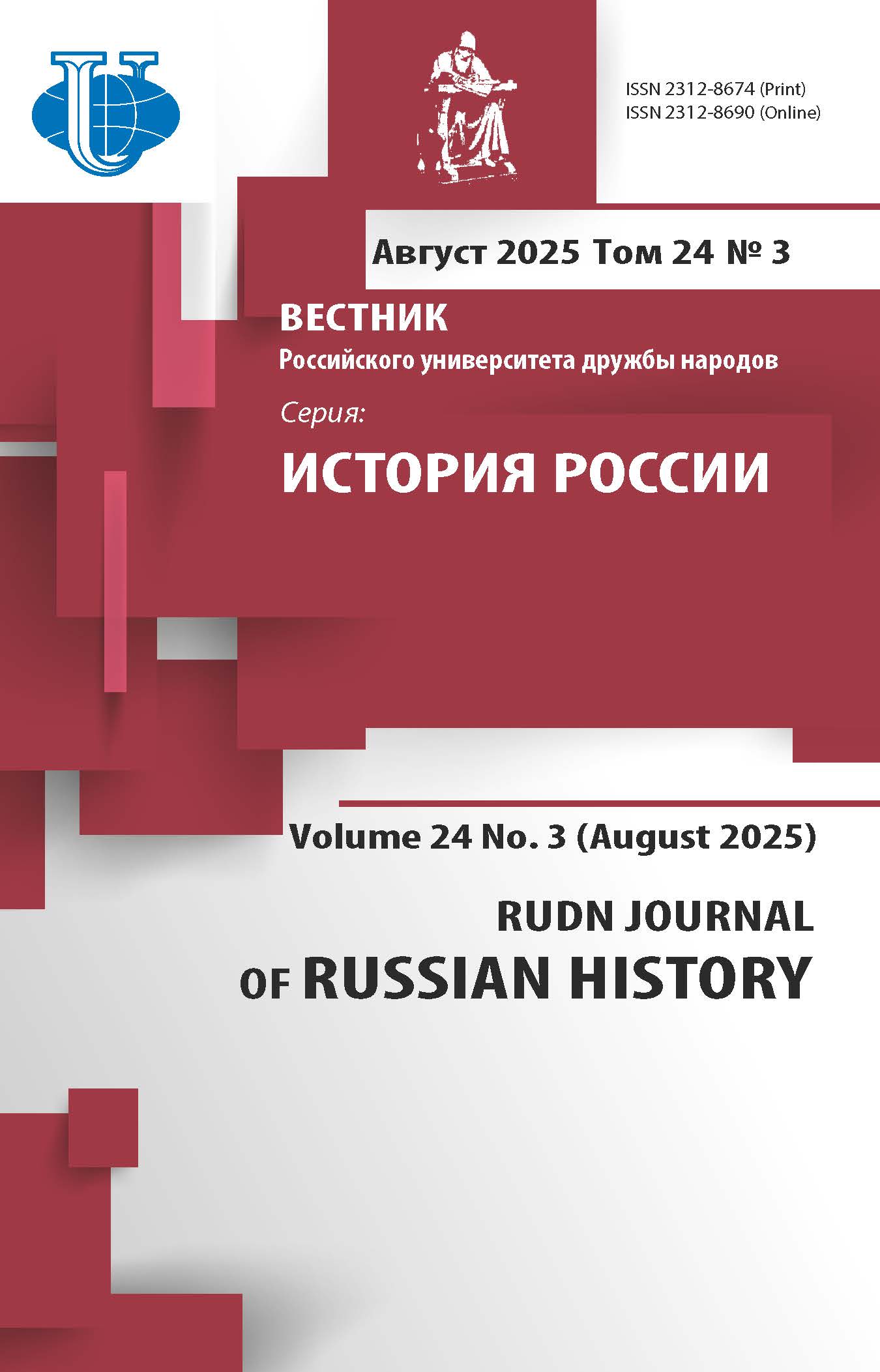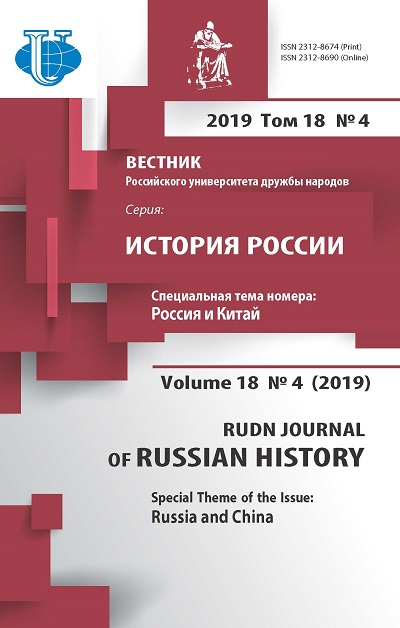Russian-China relations - connectivity to Eurasia transformation
- Authors: Vorkunova O.A.1,2, Kurylev K.P.3
-
Affiliations:
- Moscow State Linguistic University
- Primakov National Research Institute of World Economy and International Relations Russian Academy of Sciences
- RUDN University
- Issue: Vol 18, No 4 (2019): RUSSIA AND CHINA
- Pages: 828-844
- Section: RUSSIA AND CHINA
- URL: https://journals.rudn.ru/russian-history/article/view/22309
- DOI: https://doi.org/10.22363/2312-8674-2019-18-4-828-844
- ID: 22309
Cite item
Full text / tables, figures
Abstract
The article discusses Russian-Chinese relations and their impact on the state and development prospects of such an important international region as Eurasia. The authors pay special attention to the evolution of Russian-Chinese relations in historical retrospect, to the peculiarities of forming a strategic partnership between the two leading powers of Eurasia, and to the expansion of their political and economic cooperation. The article notes that the transformation of Eurasia into a significant political force in international relations was associated with qualitative changes in the global economic and political situation, with a new content of models of rivalry and cooperation. The article comprehensively examines the historical stages of the transformation of the Eurasian center of power, the processes of its elevation and fragmentation, and the place in this of Russia and China. Particular attention is paid to the specifics of Eurasian interdependence, the strengthening of innovation factors in the content and forms of the Eurasian transformation. In the analysis of the system of the Eurasian space, the authors focus on highlighting the main trends in the political sphere, strengthening the importance of the organizational forms of relations between the European Union and China, as well as on the features of Russian-Chinese relations in the post-Ukrainian period that influenced the consolidation of the Eurasian economic complex. The article analyzes the nature and nature of the relationship between the emerging Eurasian economy and the national economies of the countries included in the Eurasian space. At the same time, the authors explore the problem of organizing global and regional security spaces and forming the structure of a complex combination of horizontal and vertical ties.
About the authors
Olga A. Vorkunova
Moscow State Linguistic University; Primakov National Research Institute of World Economy and International Relations Russian Academy of Sciences
Author for correspondence.
Email: vorkunovaimemo@gmail.com
Kandidat istoricheskikh nauk [Ph.D. in History], Associate Professor at the Department of Theory of Regional Studies, Moscow State Linguistic University; senior researcher at the Primakov National Research Institute of World Economy and International Relations Russian Academy of Sciences
38, Ostozhenka St., Moscow, 119034, Russia; 23, Profsoyuznaya St., Moscow, 117997, RussiaKonstantin P. Kurylev
RUDN University
Email: kurylev-kp@rudn.ru
Doktor istoricheskikh nauk [Dr. habil hist.], Professor at the Department of Theory and History of International Relations, RUDN University.
10, Miklukho-Maklaya St., Moscow, 117198, RussiaReferences
- Akatayeva, A.A. “Shankhayskaya organizatsiya sotrudnichestva kak faktor regional’noy bezopasnosti.” In NATO i Tsentral’naya Aziya: regional’naya i natsional’naya bezopasnost’ i strategicheskoye partnerstvo, 56–61. Almaty: KazNU im. Al’-Farabi Publ., 2003 (in Russian).
- Bobrick, B. East of the Sun: The Epic Conquest and Tragic History of Siberia. New York: Poseidon Press Publ., 1992.
- Calder, K. Super Continent. The Logic of Eurasian Integration. Stanford: Stanford University Press Publ., 2019.
- Charap, S., Drennan, J., and Noel, P. “Russia and China: A New Model of Great-Power Relations.” Survival 59, no. 1 (2017): 25–45.
- Chudodeyev, Yu.V. Na glazakh menyayushchiysya Kitay. Moscow: IV RAN Publ., 2008 (in Russian).
- Chudodeyev, Yu.V. Rossiya-Kitay. Strategicheskoye partnerstvo na sovremennom etape (problemy i perspektivy). Moscow: IV RAN Publ., 2011 (in Russian).
- Delyusin, L.P. Rossiysko-kitayskiye otnosheniya i problema mnogopolyarnogo mira. Moscow: IMEPI RAN Publ., 2002 (in Russian).
- Deutch, K. Political Community and the North Atlantic Area: International Organization in the Light of Historical Experience. Princeton: Princeton University Press Publ., 1957.
- Emerson, M. “The Shaping of a Policy Framework for the Wider Europe.” Policy Brief, no. 39 (2003): 1–17.
- Emmott, B. Rivals: How the Power Struggle Between China, India and Japan Will Shape our Next Decade. Orlando: FL: Harcourt Publ., 2008.
- Gabuev, A. Friends with Benefits? Russian-Chinese Relations After the Ukraine Crisis. Carnegie: Endowment for International Peace Publ., 2016.
- Gan’shina, Ye.I. “Rossiysko-kitayskoye gumanitarnoye sotrudnichestvo v 90-ye gg. XX veka.” Vestnik RUDN. International Relations, no. 1 (2015): 88–97 (in Russian).
- Ipatova, A.S. “Istoriya rossiysko-kitayskikh otnosheniy v dokumentakh i materialakh.” Modern and Current History Journal, no. 2 (2013): 70–93 (in Russian).
- Kaple, D. “Soviet Advisors in China in the 1950s.” In Brothers in Arms: The Rise and Fall of the Sino-Soviet Alliance, 1945–1963, 117–120. Washington D.C.: Woodrow Wilson Center Press Publ., 1998 (in Russian).
- Kuzyk, B.N., and Titarenko, M.L. Kitay – Rossiya 2050: strategiya sorazvitiya. Moscow: Institute of Economic Strategy Publ., 2006 (in Russian).
- Kul’man, Yu., and Kallagan, D. “Voyennyye v obshchestve obshchego riska: elementy sravneniya po devyati stranam Zapadnoy, Tsentral’noy i Vostochnoy Yevropy.” In Voyennyye i obshchestvo v Zapadnoy i Vostochnoy Yevrope, 227–260. Moscow: Nauchnaya kniga Publ., 2000 (in Russian).
- Kurylev, K.P., Degterev, D.A., Smolik, N.G., and Stanis, D.V. “Kolichestvennyy analiz fenomena geopoliticheskogo plyuralizma postsovetskogo prostranstva.” International Organizations Research Journal 13, no. 1 (2018): 134–156 (in Russian).
- Kurylev, K.P., and Stanis, D.V. “Protsess razvitiya yevraziyskoy integratsii: istoriya, sovremennyye problemy, perspektivy.” Modern Science, no. 2 (2015): 13–18 (in Russian).
- Luzyanin, S.G. Rossiya i Kitay v Yevrazii. Mezhdunarodno-regional’nyye izmereniya rossiyskokitayskogo partnerstva. Moscow: «Forum» Publ., 2009 (in Russian).
- Luzyanin, S.G. “Global’nyye i regional’nyye izmereniya rossiysko-kitaysko-indiyskogo sotrudnichestva v tsentral’no-aziatskom rakurse.” Far Eastern Affairs, no. 2 (2007): 33–41 (in Russian).
- Luzyanin, S.G, and Mamonov, M.V. “Kitay v global’nykh i regional’nykh izmereniyakh. resursy i marshruty «vozvysheniya».” In Kitay v mirovoy i regional’noy politike. Istoriya i sovremennost’, 5–31. Moscow: IDV RAN Publ., 2011 (in Russian).
- Luzyanin, S.G. Rossiya – Mongoliya – Kitay v pervoy polovine XX v. Politicheskiye vzaimootnosheniya v 1911–1946 gg. Moscow: Ogni Publ., 2003 (in Russian).
- Mikheyev, V.V. “Mirovoy krizis kak novyye vozmozhnosti dlya kitayskoy ekonomiki.” Society and Economy, no. 6 (2009): 22–33 (in Russian).
- Mosyakov, D.V. Politika Kitaya v Yugo-Vostochnoy Azii: ot proshlogo k nastoyashchemu. Moscow: IV RAN Publ., 2012 (in Russian).
- Rakhmanin, O.B. K istorii otnosheniy Rossii–SSSR s Kitayem v XX veke. Moscow: Moskva Publ., 2002 (in Russian).
- Slubb, E. China and Russia: The Great Game. New York: Columbia University Press Publ., 1971. Sya, Ishan’. “Mekhanizm «Shankhayskoy pyaterki» i strategicheskoye vzaimodeystviye Kitaya i
- Rossii.” In Kitay v mirovoy politike, 336–351. Moscow: ROSSPEN Publ., 2001 (in Russian).
- Titarenko, M.L. Rossiysko-kitayskiye otnosheniya. Sostoyaniye i perspektivy. Moscow: IDV RAN Publ., 2005 (in Russian).
- Tsvyk, G.I. “Rossiysko-kitayskoye gumanitarnoye sotrudnichestvo v ramkakh SHOS.” Vestnik RUDN. International Relations, no. 2 (2018): 415–428 (in Russian).
- Voskresenskiy, A.D. Rossiya i Kitay; teoriya i istoriya mezhgosudarstvennykh otnosheniy. Moscow: MONF Publ., 1999 (in Russian).
- Voskresenskiy, A.D. Rossiysko-kitayskoye strategicheskoye vzaimodeystviye i mirovaya politika. Moscow: Vostok-Zapad Publ., 2004 (in Russian).
- Voskresenskiy, A.D. «Bol›shaya Vostochnaya Aziya»: mirovaya politika i energeticheskaya bezopasnost›. Moscow: LENAND Publ., 2006 (in Russian).
- Weathersby, K. “Stalin, Mao, and the End of the Korean War.” In Brothers in Arms: The Rise and Fall of the Sino-Soviet Alliance, 1945–1963, 238–276. Washington D.C.: Woodrow Wilson Center Press Publ., 1998.
- Yiwei, Wang. The Belt and Road Initiative: What Will China Offer the World in its Rise? Beijing: New World Publ., 2016.
- Yefremova, L.I. “O rossiysko-kitayskom sotrudnichestve v oblasti obrazovaniya.” Vestnik RUDN. International Relations 17, no. 4 (2017): 857–865 (in Russian).
- Yurtayev, V.I., and Rogov, A.S. “SHOS i BRIKS: osobennosti uchastiya v protsesse yevraziyskoy integratsii.” Vestnik RUDN. International Relations 17, no. 3 (2017): 469–482 (in Russian).
- Zhouying, Jin. The Future of Humanity. Global Civilization and China’s Rejuvenation. Chicago: Intellect; The University of Chicago Press Publ., 2018.
Supplementary files















